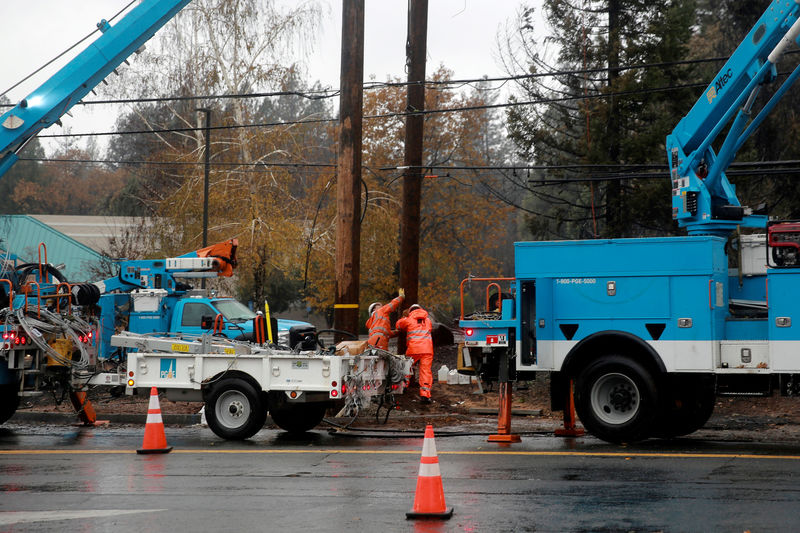By Jessica DiNapoli, Mike Spector and Scott DiSavino
(Reuters) - PG&E Corp's chances of emerging from bankruptcy proceedings hinge in part on an arcane California legal rule that threatens to keep the utility owner perpetually on the hook for liabilities from catastrophic wildfires even beyond the more than $30 billion the company expects to face from recent blazes.
The doctrine, known as "inverse condemnation," exposes California utilities to liabilities from wildfires regardless of their negligence, as long as their equipment is involved.
That legal rule could keep PG&E exposed to additional liabilities from future fires and leave the company stuck in bankruptcy limbo, according to restructuring experts and people familiar with the matter.
PG&E on Monday said it was preparing to seek bankruptcy protection as soon as this month amid pressure from potentially staggering liabilities related to wildfires in 2017 and 2018. The most recent blaze engulfed the California mountain community of Paradise, destroying homes and killing at least 86 people in the most destructive wildfire in state history.
Once PG&E files for Chapter 11 bankruptcy protection, creditors can no longer call loans or demand interest payments, lawsuits are paused, and other claimants have to get in line and be subject to the reorganization plan that the company develops.
This could allow PG&E to settle disputes more effectively, and negotiate down its legal bill from the wildfires. PG&E is hoping it can exit bankruptcy in as little as two years, according to its advisers. It envisions no negative impact on its customers.
However, exiting bankruptcy could take longer if there are more wildfires while PG&E is in bankruptcy, a real threat given that climate change has turned the blazes into an annual occurrence.
A bankruptcy judge could even refuse to approve PG&E's reorganization and exit from court proceedings if the judge finds that inverse condemnation calls into question its future as a viable company, according to U.S. law.
"Inverse condemnation is a state law but a bankruptcy judge is god," said Robert McCullough, principal at energy consulting firm McCullough Research in Portland, Oregon, noting that PG&E faces widespread lawsuits. "He's going to have to figure out, once he releases the company from bankruptcy, if it's actually a viable entity."
Private companies generally are not subject to this law, though it varies state by state, McCullough said. California's laws are more extreme than most, he said.
In a regulatory filing on Monday, PG&E questioned whether it could continue to operate as a so-called investor-owned utility while being exposed to that risk. PG&E's exposure to inverse condemnation represents a key issue the utility owner hopes to address should it seek bankruptcy protection, according to a person familiar with the matter.
PG&E challenged inverse condemnation in California's Supreme Court unsuccessfully late last year. In a legal filing, the company noted that regulators decide how much private utilities such as PG&E can charge customers, limiting their ability to mitigate pain from crushing liabilities.
PG&E also highlighted in the legal argument a decision by regulators to deny another private utility's request to recover hundreds of millions of dollars in uninsured costs resulting from settling claims related to wildfires.
That status quo will cause private utilities to "face increasing difficulty in obtaining capital from investors, threatening financial harm to the utilities and potentially rendering them economically unsustainable," the company said in the petition to California's highest court.
Absent a court intervention, it would be up to California's state politicians, including Governor Gavin Newsom, to come up with a legislative fix to inverse condemnation.
"Bankruptcy is PG&E’s response to the risk of (inverse condemnation)," said Severin Borenstein, the faculty director of the Energy Institute at the Haas School of Business at the University of California, Berkeley.
"That leads to the larger question of whether or not this bankruptcy leads to...how we have utilities in California, and if we move from private firms to government owned," he said.
LESSONS FROM PREVIOUS BANKRUPTCY
PG&E's subsidiary, Pacific Gas and Electric Company, filed for bankruptcy in 2001, offering hints on how much investors and creditors could recover this time. The subsidiary could not pay its bills during a California energy crisis caused by market manipulation that left consumers dealing with blackouts.
In PG&E's 2001 bankruptcy, creditors were repaid in full, according to company statements, an unusual scenario most companies in financial distress do not achieve.
What is more, PG&E shares continued trading between 2001 and 2004, while the subsidiary was in bankruptcy, and never dropped below $6 per share, according to Refinitiv data. PG&E shares ended trading on Monday at $8.38. Most companies lose all equity value as they face bankruptcy.
PG&E's bonds traded sharply lower Monday after the company said it was preparing for bankruptcy, indicating that holders do not expect to recover all of their investment this time.
